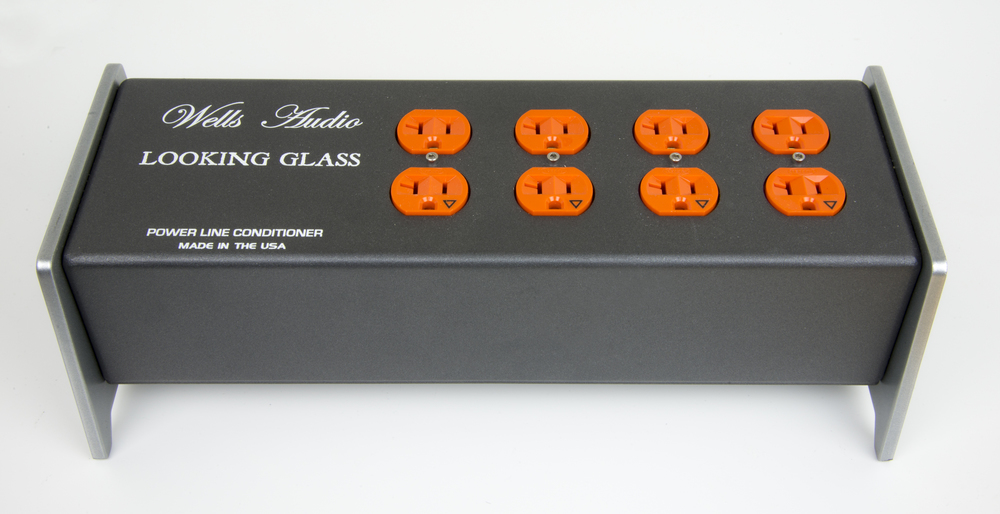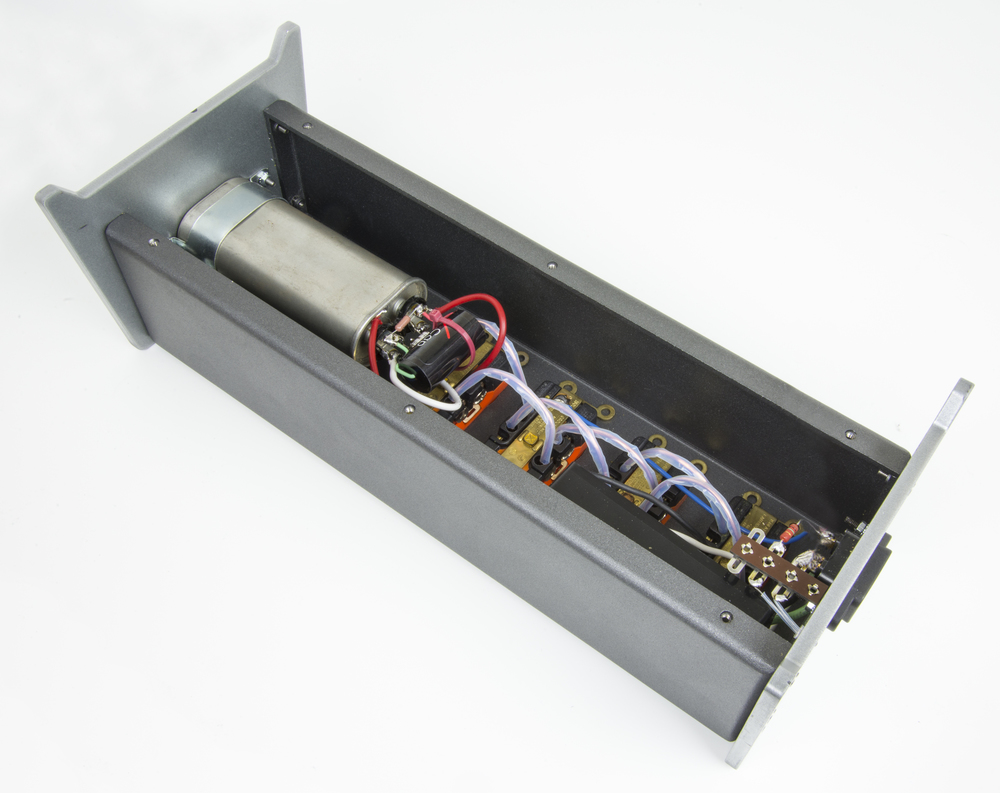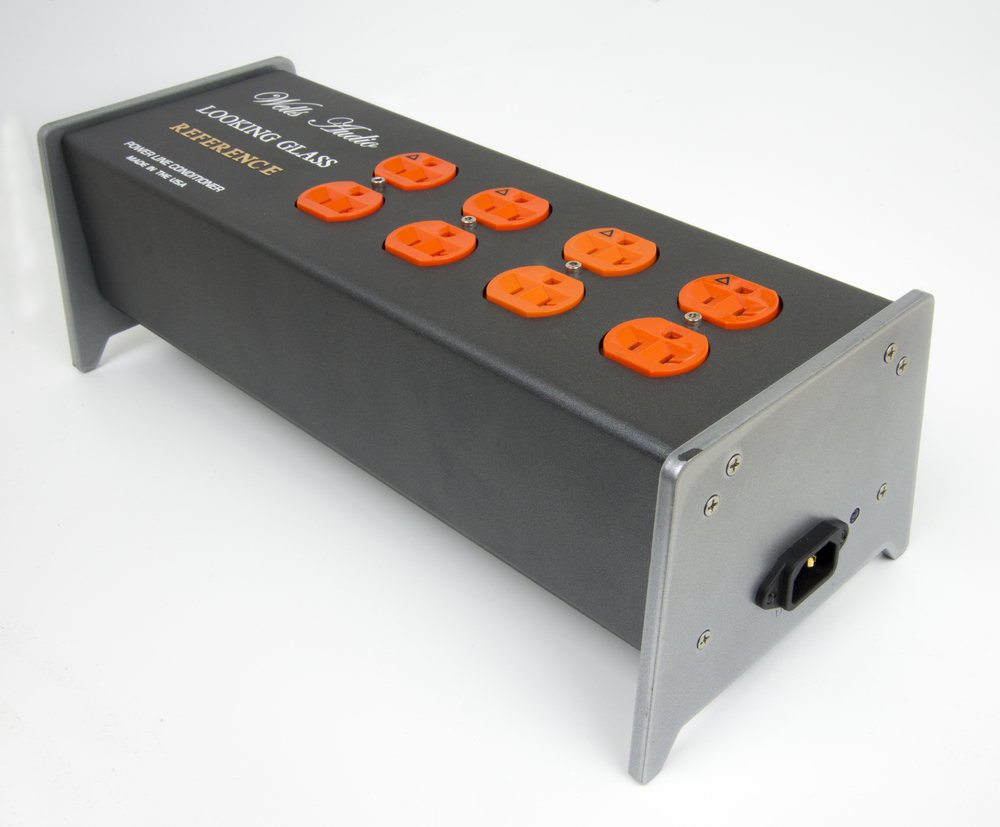Wells Audio - Looking Glass Power Conditioner - Customer Trade In!!! - BTC Now Accepted!!!
Listed · 267 Views
This listing has ended.
Listings Similar to Wells Audio
Time Left: Listing Sold
This listing has ended.
| Condition | |
| Payment methods | Contact seller |
Contact seller after sale to pay viaVISA/Mastercard, American Express, Discover, Certified check, Personal check or Wire Transfer | |
| Ships from | Wayne, IL, 60184 |
| Ships to | United States |
| Package dimensions | unspecified |
| Shipping carrier | FedEx |
| Shipping cost | $45.00 |
| Research Pricing |
Offered for sale is a Wells Audio Looking Glass Power Conditioner. This Looking Glass is a recent customer trade in and is conservatively rated as Good Condition. The power conditioner will ship double-boxed via insured FedEx ground to ensure safe arrival to its new owner.
To learn more about the Looking Glass, scroll down for information from Wells Audio's web site and a review by Francisco Duran from Positive Feedback.
INTEREST FREE FINANCE OPPORTUNITY: Next Level HiFi Is Now Offering 12 Months Interest Free Financing, To Approved Credit, On This Listing!!!
BITCOIN: Next Level HiFi Is Now Pleased To Offer Acceptance Of Bitcoin (BTC) Payment.
_________________________
MEET "LOOKING GLASS"
$1999.00
Power conditioners should do only one thing and that is to simply eliminate noise without removing dynamics and tonal color. Nearly all currently available power line conditioners on the market fail miserably to accomplish this seemingly simple task. Following in the footsteps of such monumental successes such as the Innamorata amplifier and the Majestic integrated amplifier as well as the standard setting Headtrip headphone amplifier comes the "Looking Glass" series of power line conditioners. The "Looking Glass" conditioners following our philosophy of "simplicity in design but meticulous in execution" is passive in design. This eliminates the dynamics robbing of regenerative conditioners.
“What the Looking Glass brought to my system was greater overall natural timbre and tone to the music. A highly detailed soundstage and naturally correct images. This is one product that is really going to break my heart to return. ”
— Francisco Duran, Positive Feedback
At the heart of our conditioners we use a circuit developed by John Curl and Jack Bybee as it's main filtering technology. This circuit employs a series of filtering caps and also contains a "gas module" that breaks the circuit when it senses an overcurrent condition. Once the condition has passed the gas within the module reforms and once again becomes conductive allowing the conditioner to once again function normally. The specially designed outlets have phosphor bronze contacts (the best sounding material for audio contacts), all wiring is sourced directly from the wire manufacturer and is proprietary. Wire insulation is teflon.
____________

A Creative Forum for the Audio Arts
Into the 'Looking Glass' - Wells Audio's AC Conditioner
11-21-2016 | By Francisco Duran | Issue 88Sometimes we come to the reality that a certain product in our system is not the be all and end all we thought it was. Take for instance the "built-in DAC". It is a great idea till that fast paced technology renders that chip obsolete. I have often thought that what I have my system plugged into was the best I could get. My AC line conditioner does a great job of delivering clean power to my system. Just plug everything into it and forget about it. Since I bought it, I have never had the inclination to change it for something different or supposedly better. Besides, my system does sound pretty good running through it. But wait, this is high end audio. Just like DAC technology nothing stands still. Enter the Wells Audio Looking Glass.
Honestly I have never given a thought about putting a passive line conditioner in my system. Surely you need a massive toroidal transformer in a big metal box that weighs sixty pounds, regenerating clean undistorted power to your system to keep it running good and sounding great. Well not exactly. There are numerous passive line conditioners on the market that work perfectly fine without a transformer. You can add the Wells Audio Looking Glass to that list. It is neither 60 pounds nor has a massive transformer in its light and slim chassis. Designed in conjunction with none other than John Curl and Jack Bybee, this component started out with serious credibility to say the least. The Looking Glass employs very high quality wire, copper foil capacitors, and sports some of the best outlets Furtech makes. Oh yes, it does have surge protection. Some of the design is proprietary so for more technical details and questions on the price structure please contact Wells Audio. Jeff Wells instructions to me were sparse. Make sure your whole system is plugged into the Looking Glass. With its eight outlets it handily accommodated my whole system. Even my Audioengine B1 and Roku 3 fit right in. In fact this unit didn't come with instructions. If you need them with this thing, then have a nice Lolly and be on your way.
Let's get right down to it. How accurate is my short term memory. Could I switch out my power line conditioner for this passive line conditioner, turning everything off and re-plugging everything in and still remember what the previous one sounded like reliably and accurately in the time it would take to do so? Would anybody believe I can do it? How good is my audio credibility? All these things went through my mind as I switched between PLC's and listened over the course of the review period. Lets check out some details before I answer that question.
Broken in and warmed up for days, the little Looking Glass was installed and ready to go to work. I started off with Jack Johnson's Sleep Through The Static CD. On track 8, "What You Thought You Need". The music was rendered in a very holographic manner. Not just better three dimensionally or in a hi-fi recreation of the soundstage, but vocals and instruments were placed within that space in a way that I have never heard in my system before. It sounded more real than reproduced music. Depth of stage sounded more genuine. The hollowness of Johnson's guitar was every bit a part of the performance as the sound of the strings. Instrument color and texture sounded more realistic which I feel contributed to the realness of sound I was hearing. As well as the acoustic instruments on the JJ CD, the organ on Track 1, "Joyful Noise" and Track 6, "Like Everyone Else" on The Deric Trucks Bands' first CD which was dripping with texture heretofore missing. Cymbals and snare drums on these CD's were brought to a new level of reproduction. Again I don't remember hearing reproduction this naturally realistic in my system before. The music just peeled off in layers. But wait, all I did was change out the PLC in my system. It would seem that I just found a way to improve the sound of my amplifier, DAC, and BluRay player to a very high degree with just one piece of gear being swapped out. And at the same time, reduce some grain, glare and distortion in my system I didn't know I had.
I have to mention a gem of a musician in Carlinhos Brown, a veteran of the Brazilian music scene, vocalist, composer, producer and Grammy award winner. Jeesh! This guy could make music out of anything. And on his CD, A Gente Adina Nao Sonhou, it literally seems like he went through a junk yard, picked up some choice metal and added it to the musical mix along with real instruments. It turned out beautiful. My particular favorites on this disc are Track 1, "O Aroma Da Vida" and Track 5, "Loved You Right Away". I took this trip through the Looking Glass with Carlos many times. Brown's rich and resonant voice sounded striking and so realistic. These songs were so haunting to me as I went to bed with them on my mind. There are many small and large details on this disc that are brought out beautifully. Dynamically, small instrumental taps and soft percussion strikes were hanging all over my room. It is said that large transformers in power line conditioners restrict dynamics. As far as bass reproduction, I really can't say this is so in my system with the transformer based model I use. But what I did notice with the Looking Glass in place is more the way micro dynamics naturally bloomed. Those light percussion strikes, the soft tap on a drum head, or the way a bass note cuts loose from an acoustic bass is more naturally reproduced. The clean, fast, and articulate way those notes trail off into the air was more interesting and musically fulfilling to me than the heftier bass per se. That is not to say with the right speakers or system that more solid and deep bass could not be realized. After all, my two 7-inch Fostex drivers can only reach so deep. The Carlinhos Brown CD showcased these traits very well. This project was turning into more fun than work.
Remember I mentioned short term memory retention in the third paragraph? Right now is when I needed the retention part to kick in. I switched back to my regular power line conditioner; a massive beast of a unit. I am glad I didn't have to move it because it does weigh 60 pounds. It had been sitting unplugged for quite a number of days, so I let it heat up for 24 hours by itself plugged into the wall before I went to town. Trust me, it sounded a lot better after the warm-up. Actually, it turned in a good show, a very good show. First the good parts... this unit is clean, very clean. Music was reproduced about as clean and grain free as you could get. I was surprised. I haven't taken this unit out of my system in many years. This unit let dynamics pass through unhindered. My notes read, "Great dynamics and pace. That clean and grain free presentation carried through to the soundstage and imaging. But switching these two units back and forth a few more times brought out some interesting details. After listening to the Looking Glass for a few months I was surprised to find that with my regular unit it ,was a little easier to actually hear into the music. That clean presentation again? Could the Looking Glass actually sound darker? But after careful comparisons, the important differences started to surface.
With my transformer based PLC the sound was instantly brighter. It was as if the whole presentation lit up. From the upper midrange to the top of the treble, the overall sound changed to a lighter and slightly brighter character. Detail retrieval was very good as on the Steely Dan song "My Rival" from the Gaucho CD. But the vocals sounded slightly etched with thinner textures, and not quite as natural. Cymbals, bells, and triangles rang through the air cleanly, but sounded a little stiff, and again, slightly etched and not quite as natural. The sweet, dimensional synth work that I heard on Alan Parson's Vulture Culture CD, Track 2, "Separate Lives" through the Looking Glass, now sounded flatter through my power line conditioner with a more "digital" sound. Clean, but etched and flatter sounding than the Looking Glass. Could a thing sound clean but etched at the same time? This did.
This sound translated to acoustic instruments as well. On the CD the Very Best of Anne-Sophie Mutter I wanted to press the eject button on the first track. On the Janaki String Trio's CD titled Debut, the attack, dynamics, and pace were first rate. But the timbre, tone, and overall sound of the music was slightly off coming from the ancient instruments they play. I was crushed! Another quickly noticeable trait between these two units is soundstage depth and image placement. The Looking Glass clearly renders soundstage depth and width more naturally. There is a depth and dimension to the music that consistently draws one into the performance. Instruments sounded more solid on that soundstage. My Marantz products have an upfront sound that pushes the music even with the front plane of my speakers. My power line conditioner mirrors this trait. Not so with the Looking Glass. Whatever stage depth and spaciousness is on the recording, you will hear it. This unit sounds less flat, even through my Marantz amplifier. This was especially true when I used either of my tube amplifiers. After careful comparison I concluded that images were not as sharply etched as with my PLC, and tone and timbre sounded more natural and real with the Looking Glass. This is what clearly sets these two units apart. I was surprised at how quickly and easily I could tell the differences between these two units. Especially with the time involved switching them out.
Another important benefit of using the Looking Glass pertains to the performance of my flat screen TV. I have an older Sony Bravia XBR LCD set. Lately we have noticed that the picture has improved. We attributed this to the changing of ownership from Time Warner to Spectrum. The culprit, the Wells Audio Looking Glass unit. We noticed richer colors and a clearer picture with less grain. These same performance traits were noticeable while watching DVD's and Blu-ray discs. So if you are a videophile, this unit should be at the top of your must audition list.
Even though I tried a couple of other passive line conditioners during this review, the Emotiva CMX 6 and a Brickwall Series Mode Surge Filter, they were in no way in the same league as the Looking Glass. This strongly illustrates the point that whatever you plug your system into most definitely determines the overall sound of your system. This point was driven home strongly as I compared my power line conditioner with the review unit. Although I tried to steer clear of a shoot out in this review, switching out the two units the first time I was startled by the differences. And a comparison was evident. With the performance of my PLC I think it is definitely time for a trip back to the factory for an upgrade. This kind of component is definitely not a set it and forget it product.
What the Looking Glass brought to my system was greater overall natural timbre and tone to the music. A highly detailed soundstage and naturally correct images. The benefits in video quality were also quite revealing and most welcome. This equated to better and longer listening sessions and a more enjoyable video experience. This unit helps brings the best performance out of your components. And I had the base model. I can only imagine what the top model would bring. This is one product that is really going to break my heart to return. Me, I'm going to have a nice Lolly and listen through the Looking Glass till the absolute last second I have to return it.
Looking Glass
Retail: $1900 to $6000
Wells Audio
_________________________
Our Company: Next Level HiFi is a premier retailer of the world’s finest HiFi products. We operate by appointment and offer our clients the opportunity to experience systems not heard elsewhere. We are proud to support our business partners including: Aavik, Ansuz, Børresen, Dynaudio, Focal, Naim, Nordost, Octave, Rega, REL, Soulution.
Payment can be made by Check, Cash, Money Order, Credit Card, or PayPal. Credit Card or PayPal adds 3% to the total.
Illinois Residents add 7% to the total.
Local pickup is available as well.
Feel free to contact us at the following for questions, appointment requests, and or orders:
o: 630-797-5117
c: 630-246-0390
f: 630-830-0395
e: [email protected]
w: www.nextlevelhifi.com
No questions have been asked about this item.
Ask the seller a public question
You must log in to ask a question.
Return Policy
Return Window
Returns are not accepted on this item.





